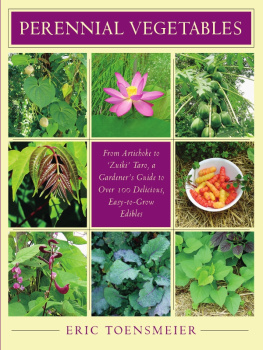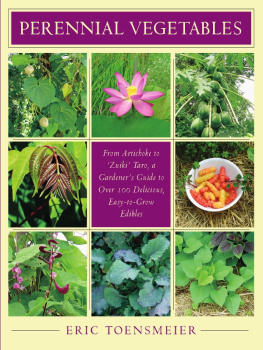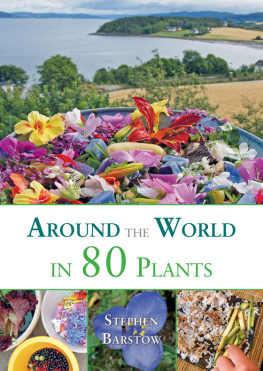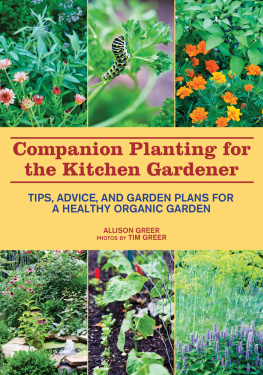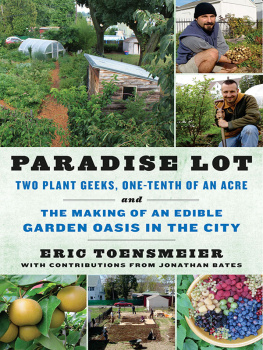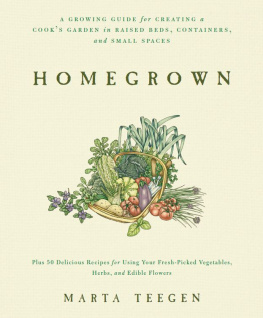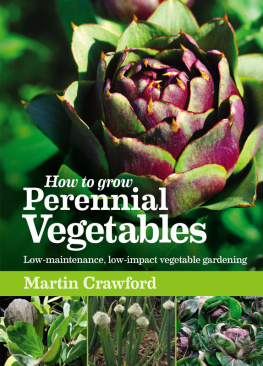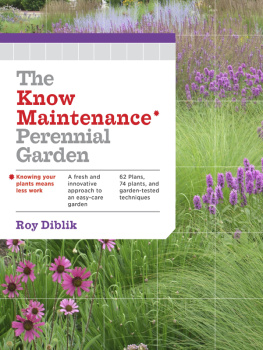
PERENNIAL VEGETABLES
PERENNIAL VEGETABLES

From Artichoke to Zuiki Taro,
a Gardeners Guide to Over 100
Delicious, Easy-to-Grow Edibles
Eric Toensmeier
Chelsea Green Publishing
White River Junction, Vermont
Copyright 2007 by Eric Toensmeier. All rights reserved.
No part of this book may be transmitted or reproduced in any form
by any means without permission in writing from the publisher.
Illustrations 2007 by Elayne Sears.
Editor: Ben Watson
Project Manager and Copy Editor: Collette Leonard
Proofreader: Laura Jorstad
Design: Robert Yerks, Sterling Hill Productions
Design Assistant: Abrah Griggs, Sterling Hill Productions
Printed in the United States
First printing, May 2007
10 9 8 7 6 5 4 3 2 08 09 10 11 12
Our Commitment to Green Publishing
Chelsea Green sees publishing as a tool for cultural change and ecological sterwardship. We strive to align our book manufacturing practices with our editorial mission, and to reduce the impact of our business enterprise on the environment. We print our books and catalogs on chlorine-free recycled paper, using soy-based inks, whenever possible. Chelsea Green is a member of the Green Press Initiative (www.greenpressinitiative.org), a nonprofit coalition of publishers, manufacturers, and authors working to protect the worlds endangered forests and conserve natural resources.
Perennial Vegetables was printed on 68-lb Renew Matte, a 20 percent post-consumerwaste recycled paper supplied by RR DonnelleyWillard, OH.
Library of Congress Cataloging-in-Publication Data
Toensmeier, Eric.
Perennial vegetables : from artichoke to zuiki taro, a gardeners guide to over 100 delicious,
easy-to-grow edibles / by Eric Toensmeir [sic].
p. cm.
Includes bibliographical references.
eBook ISBN: 978-1-603581-38-7
1. Vegetables. 2. Vegetable gardening. 3. Perennials. I. Title.
SB320.9.T64 2007
635dc22
2006102256
Chelsea Green Publishing Company
Post Office Box 428
White River Junction, Vermont 05001
(802) 295-6300
www.chelseagreen.com
Contents
Part I:
Gardening with Perennial Vegetables
Part II:
Species Profiles
Part III:
Resources

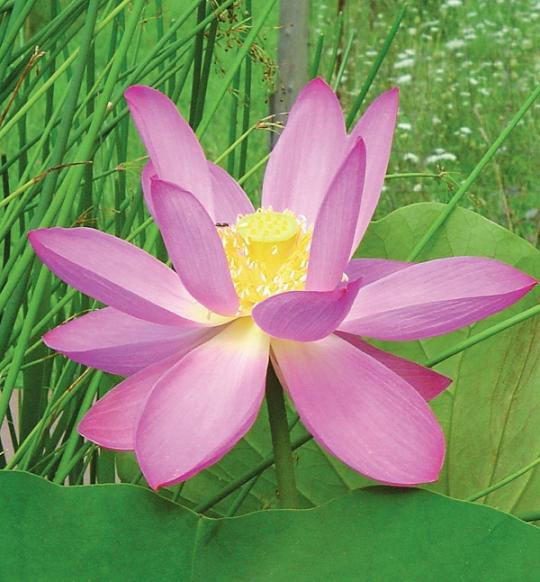
Water lotus is not only an outstanding ornamental, but also an important root crop in much of Asia.
In the summer of 2002, in a rented RV dubbed Maxine, four friends and I drove the length of Florida. My good friend and plant geek extraordinaire Craig Hepworth was our guide, and took us to wonders like ECHO, the Fruit and Spice Park, and the legendary Grimmel Grove in the Keys. In a mere six days we sampled a remarkable 62 species of fruit. While driving through the Everglades, I mentioned that Ben Watson of Chelsea Green had asked me to write a book on perennial vegetables. By the end of an hour my friends had me convinced that I should go for it. Without their support I would not be typing these words right now. To Craig, Jonathan, Darini, and Scott, thank you.
When in 1989 I first discovered permaculture and the agriculturally productive ecosystems it promoted, I was sure that comprehensive lists of perennial vegetables had been developed. But as I investigated further in college, it became clear that, unlike fruits and nuts, there was no one place to turn for information on perennial vegetables. I began to piece together information from various sources, with help from Steve Breyer of Tripple Brook Farm and my trusty copies of Cornucopia and Hortus Third. To fill the gap, I founded and ran the Perennial Vegetable Seed Company for several years. While a nice idea, it turned out that it was a bit before its timeand that I was clearly not cut out for the seed business.
It was during the years of the seed company that Jonathan Bates came to live with me. He quickly became my gardening partner and fellow plant geek. He carried much of the weight of the seed company in its last and most successful year, and together we grew out many perennial vegetablesseveral were from seeds imported from Europe. We learned how they grew, how they looked, and how they tasted (some terrible!). We stayed for three years, and then moved our whole garden to our current home, where we have quite a nice little garden (most of the photos in this book come from our garden, including many of the tropicals). So thanks, Jonathan, for sharing the excitement, for being such a swell, reliable guy, and putting up with the craziness of my writing for these past years.
Thanks to my parents, who both helped out with the challenging financial aspects of writing at key times, which made this book possible in a very real way. My mother came and spent many weekends, keeping me company while I wrote. Visits to my father in Arizona, and his fantastic cactus garden, built my understanding of arid-climate gardening.
Thanks as well to the crew at Chelsea Green Publishing. As I write the process is not quite complete, but I can say a big thanks to senior editor Ben Watson for proposing the book several times over the years, and sticking with me through a good bit longer than the year of writing we initially anticipated. The whole production and editing team has been great to work withthus far John Barstow and Collette Leonard have been especially helpful. I am grateful to President Margo Baldwin for raising the flag of permaculture at Chelsea Greenthey have become the premier North American permaculture publisher. Thanks also to Elayne Sears for her fantastic illustrations. Having worked with her on EdibleForest Gardens, I knew what she was capable of and was able to build the book around the visual element.
Thanks to my pals Dave Jacke, Craig Hepworth, Jonathan Bates, Michelle Wiggins, and my mom, who reviewed several drafts. Thanks also to everyone who supplied photographs, including Ethan Rowland, Dave Jacke, Craig Hepworth, Judy Dolmach, Jay Ram, Brock Dolman, and Jonathan Bates. My coworker Jaime Iglesias, and friend and farmer Fermn Galarza, along with so many others from Nuestras Races, have shared with me many stories of life in rural Puerto Rico, and the role of many perennial vegetables in home gardens and homesteads there. Author, farmer, and teacher Miranda Smith has been a great guide through the whole writing and publishing process for this book (and for my previous one).
There are a few organizations out there that have pioneered work on perennial vegetables. They still stand out as demonstration centers, researchers, writers, and nursery sources for rare but important plants. Educational Concerns for Hunger Organization (ECHO) in Fort Myers, Florida, hosted me, allowed me to use their fantastic library, and was the location for most of my best photos as well as home of an inspirational edible landscape. Special thanks to the very busy Dr. Martin Price, who granted me a valuable interview in person, and site manager Danny Blank, who has provided special tours for me over many years. Plants for a Future in Cornwall, England, an organization that I visited in 1997, has done so much to promote temperate-climate perennial crops, including a great demonstration site, nursery, book, and online database. The Occidental Arts and Ecology Center in Occidental, California, likewise has amazing gardens, a nursery offering great perennial vegetables, and courses and workshops to promote permaculture. They have been great with me on the phone, and I hope to visit someday. Finally, though now defunct, Triades in Hawaii did incredible work, particularly publishing the
Next page
